
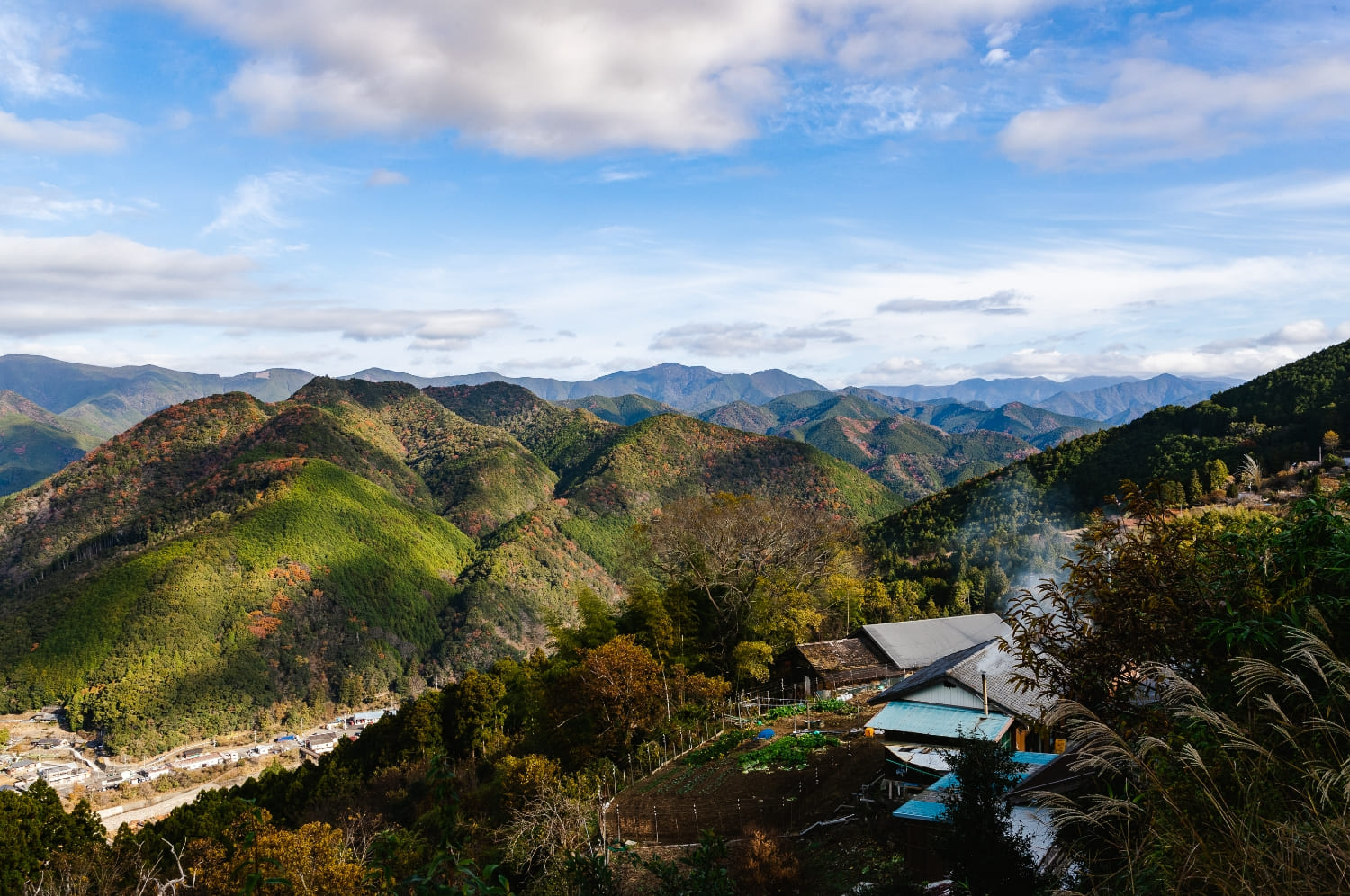
Kumano Nachi Taisha and Nachi Falls|History and attractions to know before visiting.
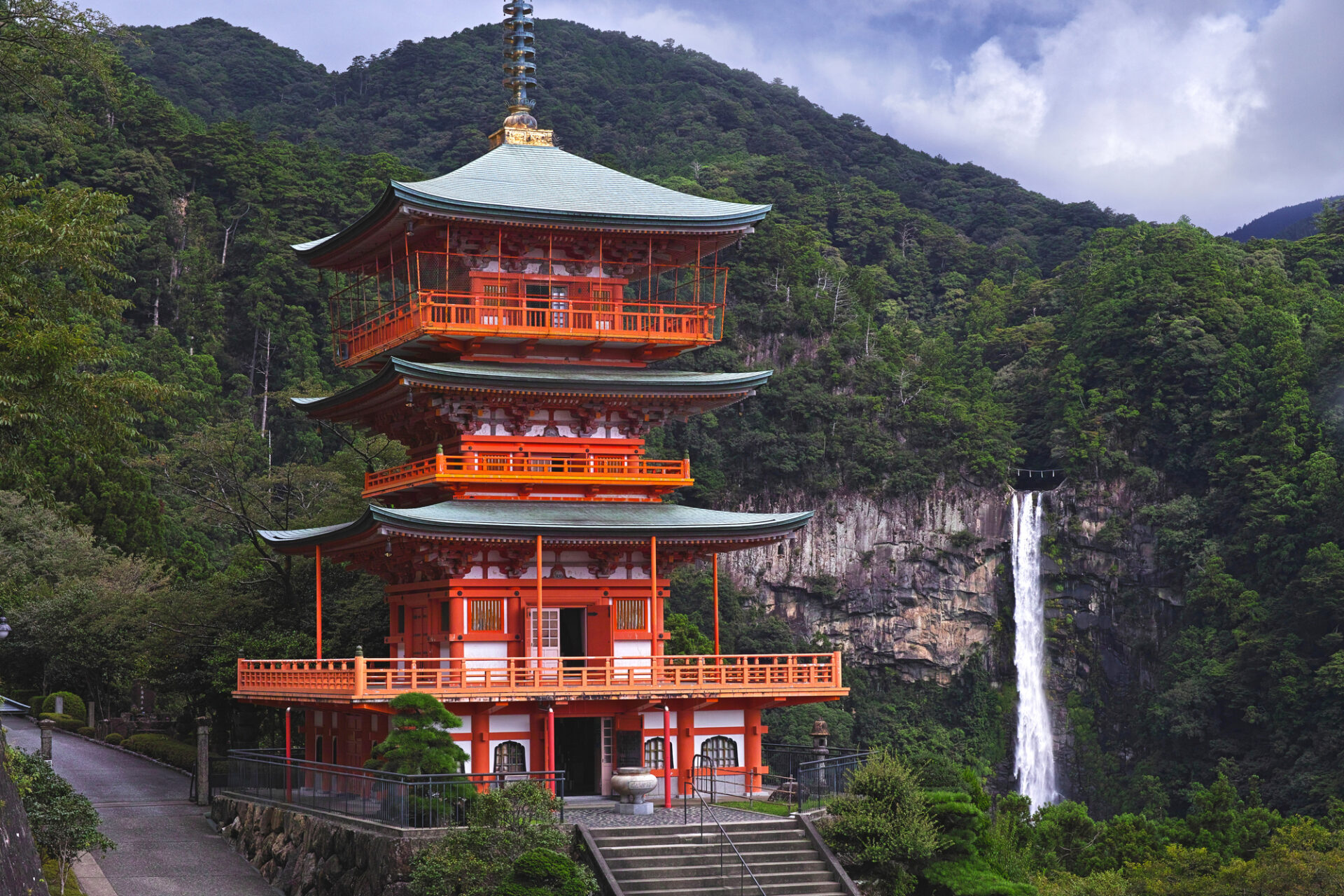
Kumano Nachi Taisha, located in Nachikatsuura Town, Wakayama Prefecture, is one of the three grand shrines known as the Kumano Sanzan. Along with Kumano Hongu Taisha in Tanabe City and Kumano Hayatama Taisha in Shingu City, it serves as a spiritual center and the head shrine for more than 4,000 Kumano shrines across Japan. The pilgrimage routes to the Kumano Sanzan, collectively known as the Kumano Kodo, are registered as a UNESCO World Heritage Site — making Kumano Nachi Taisha part of this prestigious listing.
In this article, we explore the history of Kumano Nachi Taisha and highlight the must-see spots and attractions around the shrine. You’ll also find useful information on goshuin (red seals), access, and parking.
What is Kumano Nachi Taisha? What are its history, deities, sacred charms, and goshuin (red seals)?
In this article, we introduce the history and unique features of Kumano Nachi Taisha — one of the three grand shrines known as the Kumano Sanzan — along with the reasons it was designated a UNESCO World Heritage Site and the deities enshrined there.
By learning about its history and significance in advance, you’ll appreciate your visit to Kumano Nachi Taisha even more.
History and features of Kumano Nachi-taisha shrine
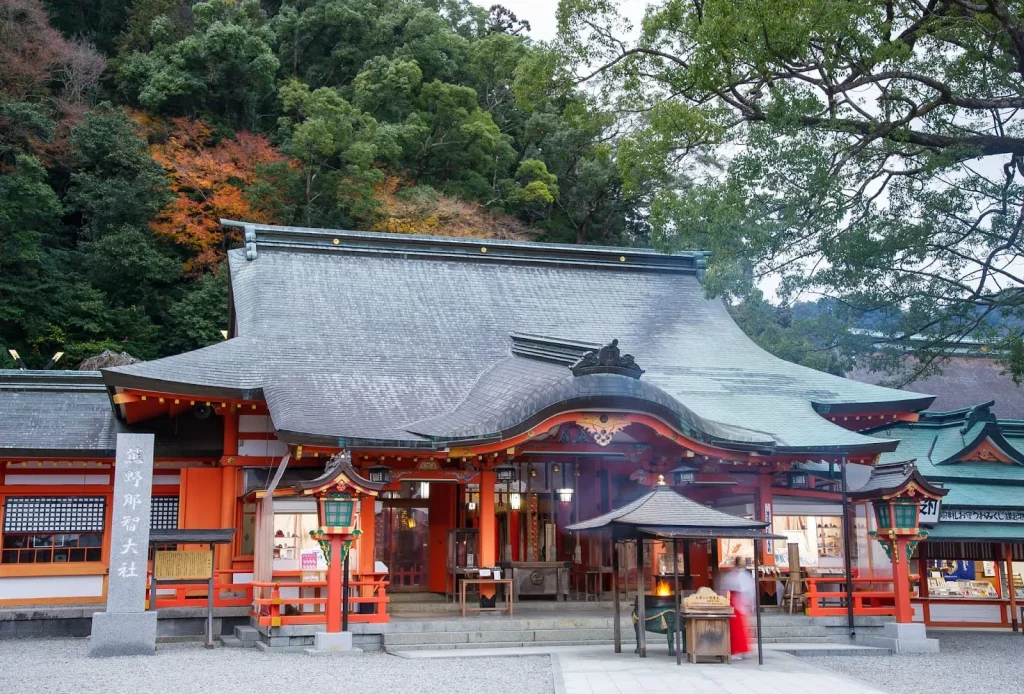
According to legend, as far back as 662 B.C., Kaminihonibanyohiko-no-mikoto — later known as Emperor Jinmu, the first emperor of Japan — landed on what is now Nachi-no-hama. As his party traveled toward the shining mountains, they discovered the magnificent Nachi Waterfall. The waterfall was revered as the sacred embodiment of the deity Ōkuninushi-no-Kami. It is also said that the three-legged crow, Yatagarasu, guided the group, and upon completing its task, transformed into stone, resting eternally as the Karasu-ishi (“Raven Stone”).
The Nachi area is home to numerous waterfalls, the most famous being Nachi-no-Taki (Nachi Waterfall). Also known as the “First Waterfall,” it has the highest drop in Japan at 133 meters. The overwhelming scale and beauty of the falls are truly breathtaking. Even before Kumano Nachi Taisha Shrine was constructed, the area around the waterfall was considered sacred and venerated as a dwelling place of the gods.
Because Kumano Nachi Taisha originated from ancient nature worship that revered the Nachi Waterfall, the shrine was established later than Kumano Hongu Taisha and Kumano Hayatama Taisha, the other two shrines of the Kumano Sanzan. Historical records suggest that the shrine was first built halfway up the mountain in 317 A.D. (the 5th year of Emperor Nintoku’s reign). At that time, the site corresponded to what is now Tobitaki Shrine, which continues to enshrine the sacred Nachi Waterfall as a subsidiary shrine of Kumano Nachi Taisha.
During the spread of Shinto-Buddhist syncretism — the belief that the Shinto kami and Buddhist deities are one and the same — Kumano Nachi Taisha was merged with the neighboring Nyoirindō, now known as Seigandō-ji Temple. By the Edo period (1603–1868), numerous shaso-bosha (temples dedicated to the care of shrines) were established in the surrounding area.
In the Meiji era (1868–1912), when the government abolished Shinto-Buddhist syncretism, the Buddhist facilities at Kumano Hongu Taisha and Kumano Hayatama Taisha were dismantled. However, Nyoirindō at Kumano Nachi Taisha remained intact because it was part of the famous Saigoku 33 Kannon Pilgrimage in western Japan. Today, it continues to exist independently as Seigandō-ji Temple.
World Heritage Site “Sacred Sites and Pilgrimage Routes in the Kii Mountain Range” and Kumano Nachi Taisha

The “Sacred Sites and Pilgrimage Routes in the Kii Mountain Range,” including the famous Kumano Kodo, was inscribed as a UNESCO World Heritage Site in 2004. It was the first cultural landscape in Japan to be added to the World Heritage List. Kumano Nachi Taisha is one of the sacred sites along this historic pilgrimage route.
Kumano has long been revered as a sacred land that welcomes and saves everyone — from nobles and warriors to commoners — regardless of status or gender. Seeking blessings for good health, longevity, and the fulfillment of their wishes, countless pilgrims made their way to the Kumano Sanzan (the three grand shrines of Kumano). The stream of pilgrims was so constant that the route became known as the “Ant Trail to Kumano” (Ari no Kumano Mode). Historical records note that, during the late Heian period, emperors such as Emperor Toba, Emperor Go-Shirakawa, and Emperor Go-Toba visited the Kumano shrines multiple times.
In those days, a pilgrimage from the capital to the Kumano Sanzan meant a journey of approximately 600 kilometers round trip, taking about one month on foot. Unlike today, the journey was perilous, often considered a life-or-death undertaking. This arduous “Kumano Pilgrimage” was seen as a symbolic journey of death and rebirth — descending to the land of the dead, being spiritually renewed, and returning to the present world. This is why the Kumano Sanzan is often called “the land of rebirth.”
What deities are enshrined at Kumano Nachi Taisha?
At Kumano Nachi Taisha, the same twelve deities (kami) enshrined at the three Kumano Sanzan shrines — Kumano Hongu Taisha, Kumano Nachi Taisha, and Kumano Hayatama Taisha — are worshipped.
The main deity (shusaijin) of Kumano Nachi Taisha is Kumano Fusumi no Ōkami (Fusumi no Ōkami), also known as Izanami no Mikoto, a goddess in Japanese mythology. The name Fusumi is derived from the words musubi (to create, to tie) and musu (to generate or develop), symbolizing creation and growth. As the goddess of creation and nurturing, she is revered as a protector of agriculture, forestry, and fisheries, as well as a deity of matchmaking and harmonious relationships.
Additionally, the Nachi Waterfall itself is worshipped as a sacred embodiment (goshintai) of Ōnamuchi no Mikoto (Ōkuninushi), a prominent deity known from the Izumo Fudoki as a creator of lands and nations. This deep connection with nature reflects the ancient belief that divine spirits dwell within natural features such as waterfalls, forests, and mountains.
Goshuin and Omamori (Sacred Seals and Charms)
At Kumano Nachi Taisha, you can receive several types of goshuin (sacred seals), including the main seal stamped with the mark of “Japan’s Number One Sacred Site”, the seal from the Miagatahiko Shrine (Miagatahiko-sha), which is located within the same precinct, and the seal of Nachi Waterfall (Nachi-no-Otaki).
Special, limited-edition goshuin are sometimes available during certain periods.
In addition, although not a goshuin, you can also receive the Karasu-Guo Shinfuda (Karasu-Gyuo Shinfuda), a sacred talisman written one by one using ink made with the water from Nachi Waterfall.
As for omamori (protective charms), Kumano Nachi Taisha offers a variety of them, such as the “Victory Charm” (Katsu-mamori) and “Guidance Charm” (Michibiki-mamori), both featuring Yatagarasu, the divine three-legged crow known as the guiding deity, and the “Longevity Water Charm” (Enmei-mizu-mamori), inspired by the sacred waters of Nachi Waterfall, believed to bring blessings of longevity.
A Must-See! Highlights of Kumano Nachi Taisha
When visiting Kumano Nachi Taisha, there are several spots you simply can’t miss. From the iconic Nachi Waterfall to popular sightseeing locations around the shrine, here’s a complete guide to help you explore the area to the fullest!
Daimon-zaka (Daimon Hill)
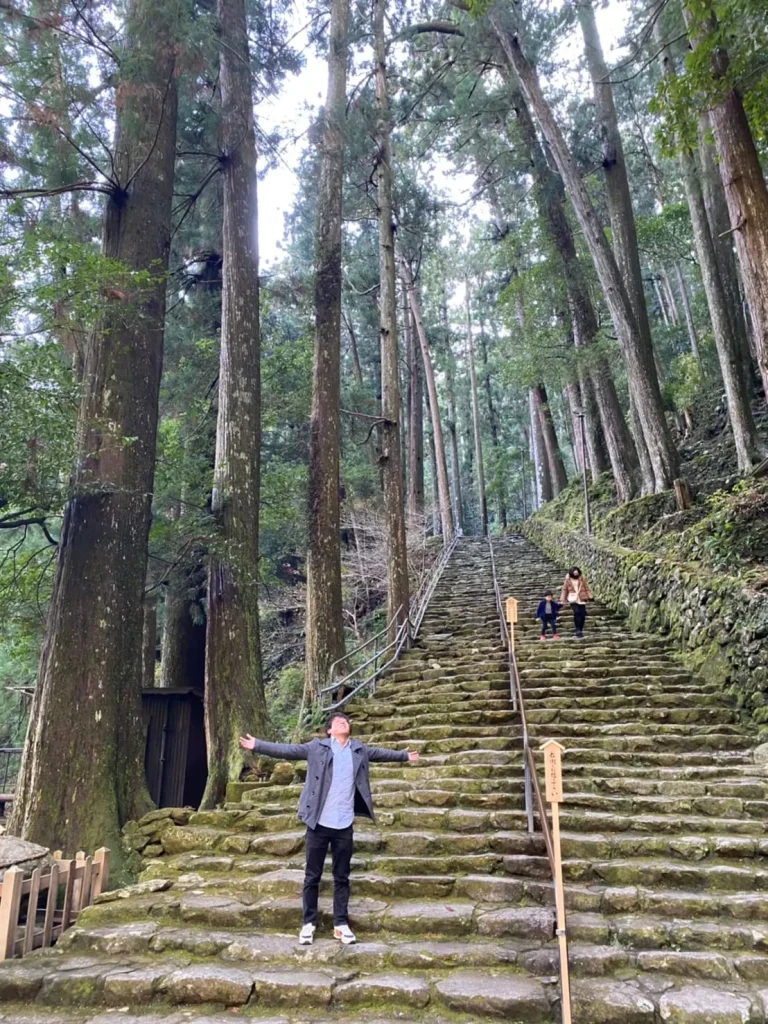
To begin your visit, climb the 463 stone steps, about 600 meters long, along the cedar-lined approach to pay your respects at the main shrine (Gohonden) and Reidō of Kumano Nachi Taisha. This slope is known as Daimonzaka.
Along the way, you’ll come across the red bridge called Furigasebashi, said to mark the border between the secular and sacred worlds. Beside the bridge are the remains of the Osakaya Ryokan, where the renowned naturalist Minakata Kumagusu once studied slime molds, and the ruins of an old checkpoint.
Cross the bridge, and you will see the majestic Meoto-sugi (Couple Cedars), twin cedar trees estimated to be around 800 years old, standing 54.5 meters tall, with a trunk circumference of 8.5 meters and branches spanning 13 meters. Beyond this point, the path continues through a beautiful avenue of cedars that are 200–300 years old.
At the Daimonzaka parking area, you’ll find a monument featuring Yatagarasu, the sacred three-legged crow and the symbol of Kumano Nachi Taisha. The monument commemorates Nadeshiko Japan’s victory at the 2011 FIFA Women’s World Cup and their silver medal at the London Olympics, with imprints of the players’ footprints on display — a must-see for soccer fans.
For access, you can take a bus or car to reach the trailhead easily.
Kumano Nachi Taisha|Gohondo and Reido
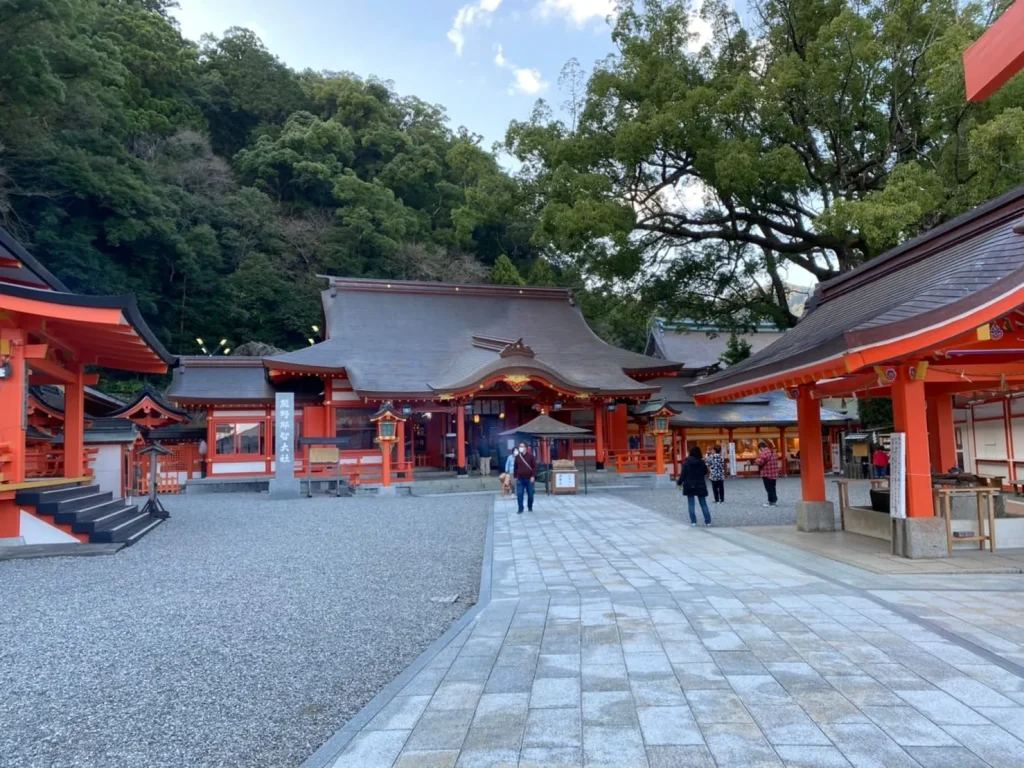
The main shrine (Gohonden) and Reidō of Kumano Nachi Taisha are located at an elevation of about 500 meters, at the top of the sacred Daimonzaka slope. If climbing the stone steps is too physically demanding — or if you’re using a wheelchair — don’t worry. You can easily access the area near the main shrine by car or bus.
The shrine complex consists of six buildings, each dedicated to a different deity:
- First Hall – Takimiya (Ōnamuchi no Kami)
- Second Hall – Shōseidō (Ketsumiko Ōkami)
- Third Hall – Naka-no-Mae (Miko Hayatama no Ōkami)
- Fourth Hall – Nishi-no-Mae (Kumano Fusumi no Ōkami) (the main enshrined deity)
- Fifth Hall – Wakamiya (Amaterasu Ōmikami)
- Sixth Hall – Hassha-den (Tenjin Chigi – the Eight Heavenly and Earthly Deities)
The main deity, Kumano Fusumi no Ōkami, is enshrined in the fourth hall from the right. In front of the main shrine stands the Reidō, which is also dedicated to Kumano Fusumi no Ōkami.
Mi-agata Hikosha.
The Miagatahiko Shrine, located to the left of the main hall, is dedicated to Yatagarasu, the legendary three-legged crow that guided the way to the discovery of Nachi Waterfall. In front of the shrine stands a stone statue of Yatagarasu.
Many people may recognize Yatagarasu as the emblem of the Japan Football Association. It is revered as a divine guide that leads people in the right direction.
Karasuishi (crow stone) and weeping cherry blossom
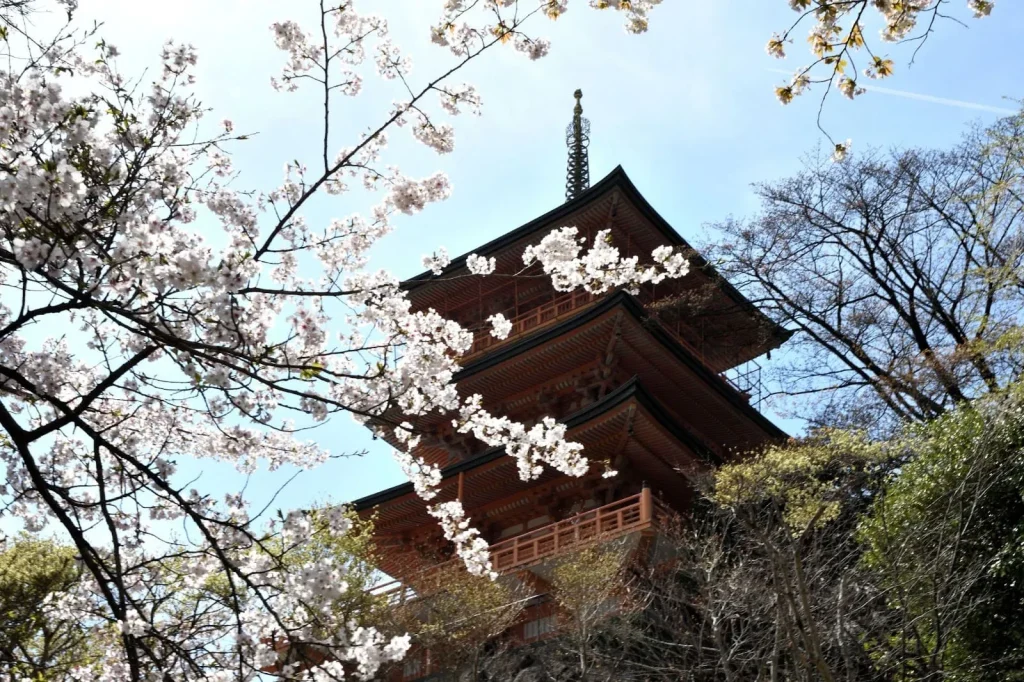
The Karasu-ishi (Crow Stone) is said to be the stone into which Yatagarasu, the legendary three-legged crow, transformed after guiding Japan’s first emperor to the Nachi Waterfall. It is located in the garden of the main shrine. The stone is also depicted in the Nachi Sanmiya Mandala, a painting from the Muromachi period (1336–1573), showing that it has stood in the same place since ancient times.
Beautiful weeping cherry trees are planted around the Karasu-ishi, making it a must-see spot during the cherry blossom season, from late March to early April.
Treasure Hall
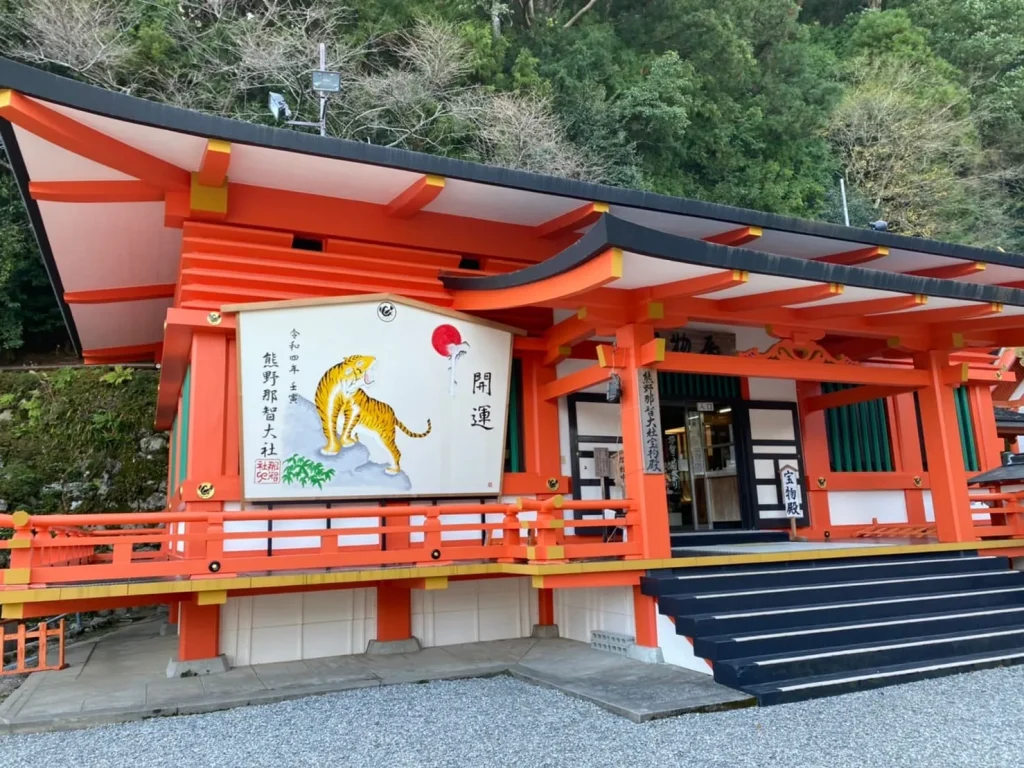
Kumano Nachi Taisha is home to numerous valuable cultural assets, including votive offerings and ritual implements that reveal its deep connections with the Imperial Court and the Shogunate, as well as historical records showing that worshippers once came from all over Japan.
At the Treasure Hall, you can explore a permanent exhibition featuring swords, ancient mirrors, ritual implements, pilgrimage mandalas, historical documents, and artifacts excavated from sutra mounds. These displays offer a fascinating glimpse into the history of Kumano Nachi Taisha and the Kumano Kodo pilgrimage routes.
Admission Fees
- Adults: ¥300
- Children: ¥200 (Elementary and junior high school students)
- Preschool children: Free
Opening Hours
- 8:30 AM – 3:30 PM
Closed
Wednesdays
Kusu (large camphor tree), the first step in the journey from the womb to the grave
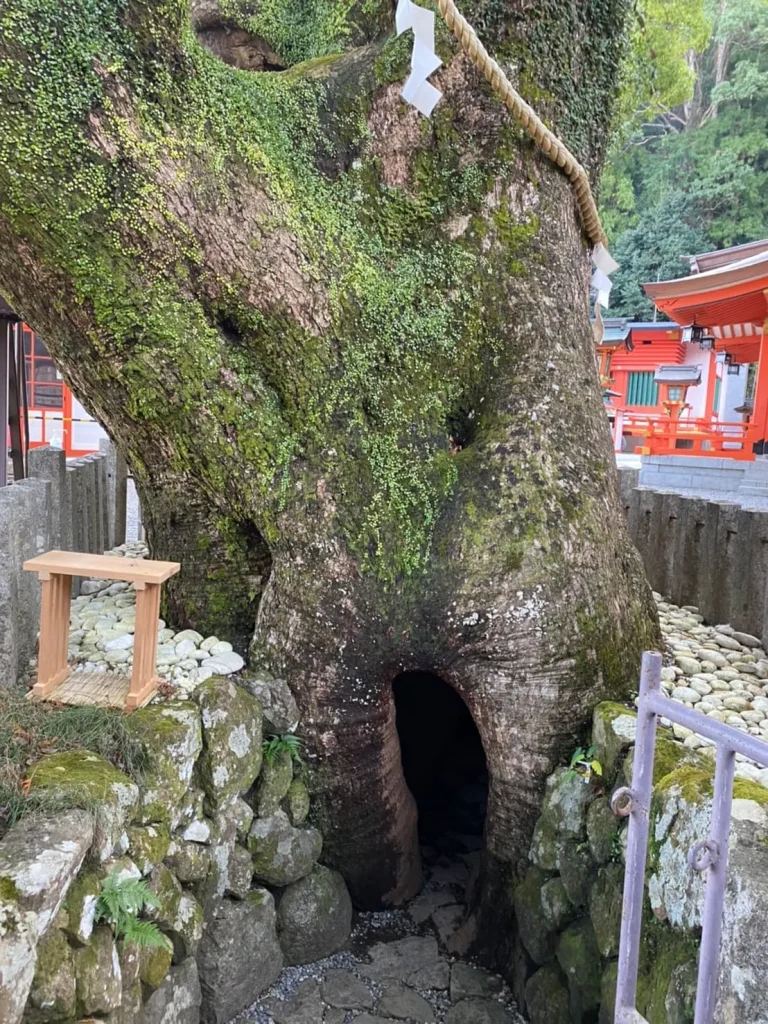
Next to the Reidō stands a magnificent camphor tree, estimated to be around 850 years old, said to have been planted by Taira no Shigemori. The tree soars to a height of 27 meters with a trunk circumference of approximately 8.5 meters, and is also known as Shōreisha (Camphor Spirit Shrine).
A large hollow in its trunk allows visitors to write their wishes on gomagi (wooden prayer sticks, ¥300) or ema (wooden plaques, ¥500) and pass through the opening while holding them. This sacred ritual, known as Tainai Kuguri, symbolizes purification and spiritual rebirth.
Seigandouji Temple

The Nachi area was once a major center of Shugendō (mountain asceticism) due to the practice of shinbutsu shūgō — the syncretism of Shinto and Buddhism. Until the Edo period, Kumano Nachi Taisha and Seigandō-ji Temple were regarded as one, but they were separated when the government abolished this syncretism during the Meiji era.
Seigandō-ji is a Tendai sect temple with Nyoirin Kannon Bosatsu as its principal deity. As the first temple (Dai-ichiban) of the Saigoku Sanjūsansho, Japan’s oldest Kannon pilgrimage, it has been visited by countless pilgrims since ancient times.
The Saigoku Sanjūsansho pilgrimage consists of 33 sacred sites dedicated to Kannon Bodhisattva, spanning about 1,000 kilometers across two urban prefectures and five other prefectures, including Wakayama. According to legend, King Enma (Yama) encouraged this pilgrimage so that people could encounter the compassion of Kannon Bodhisattva and find salvation from suffering. In 988 (Eien 2), Retired Emperor Kazan designated Seigandō-ji as the first stop of this historic route.
The current main hall, rebuilt in 1590 (Tenshō 18) by order of Toyotomi Hideyoshi, is now designated as a National Important Cultural Property. National Important Cultural Property and was rebuilt by Toyotomi Hideyoshi in 1590 (Tensho 18).
Nachi Waterfall (Nachi no Taki).

The Nachi Waterfall (Nachi-no-Otaki) is one of the most iconic landmarks of Nachi and has been revered as a sacred object of nature worship since ancient times.
The Nachi area is surrounded by a series of mountains about 800 meters high, known as Ōtori Koshikoshi, from which streams flow down to form many waterfalls. Among them, the most prominent is Nachi Waterfall, also called the “First Waterfall.” It is celebrated as one of the Three Great Waterfalls of Japan and is part of the UNESCO World Heritage Site, as well as being designated a National Place of Scenic Beauty, together with the upstream Ni-no-Taki and San-no-Taki waterfalls.
With a height of 133 meters, a mouth width of 13 meters, and a basin depth of over 10 meters, the waterfall releases an impressive one ton of water per second, making it the tallest single-drop waterfall in Japan.
According to legend, an elixir of immortality lies within the basin, and since ancient times, the water of Nachi Falls has been regarded as the “water of longevity.” Even today, many visitors come to pray and drink the sacred water. There is also a viewing platform called the Otaki Worship Stage, where you can see the waterfall up close and even sample its pure, refreshing water.
If you make it this far, don’t miss the chance to witness Nachi Waterfall, the sacred site that marks the origins of Kumano’s nature worship.
Entry Fees for the “Waterfall Worship Stage”
- Adults: ¥300
- Elementary and junior high school students: ¥200
- Preschool children: Free (no ticket required)
Hours of Visitation
9:00 AM – 5:00 PM
Hiro-jinja Shrine, a separate shrine of Kumano Nachi-taisha

Hirō Shrine is a branch shrine of Kumano Nachi Taisha, dedicated to the Nachi Waterfall itself. The waterfall is worshipped as the sacred body (goshintai) of Ōnamuchi no Kami, a deity in Japanese mythology.
Because the waterfall itself is the object of worship, Hirō Shrine has neither a main hall nor a worship hall, making it a rare type of shrine where visitors pray directly to the waterfall. From the main hall of Kumano Nachi Taisha, it takes about 15 minutes on foot down the stone steps to reach Hirō Shrine.
How to get there? Getting to Kumano Nachi Taisha
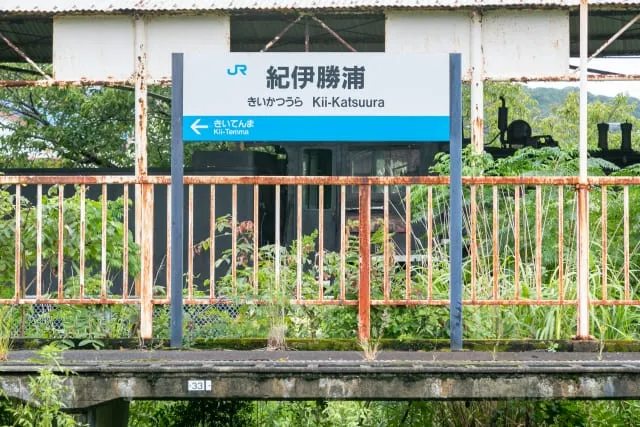
If you’d like to enjoy a trekking experience from JR Kii-Katsuura Station, it takes about 2.5 hours of walking along a gentle uphill path to reach Kumano Nachi Taisha.
If you prefer a shorter walking distance or wish to go directly to the main shrine, please refer to the information below for alternative access options.
If You Choose to Hike Up Daimonzaka
By Bus
From JR Kii-Katsuura Station, take a Kumano Gobo Nankai Bus bound for Nachisan (approx. 20 minutes).
↓
Get off at the Daimonzaka bus stop.
↓
Walk up the Daimonzaka slope (approx. 2.7 km, about 1 hour).
Note: Buses operate from around 6:00 AM to 6:00 PM, so please check the schedule in advance.
Fare: ¥430
By Car
Park at the Daimonzaka parking lot, then walk up the slope (approx. 1 hour).
Parking Lot Address:
〒649-5302
3034-2 Ichinono, Nachikatsuura-cho, Higashimuro-gun, Wakayama Prefecture
Estimated Driving Time:
- About 1 hour 45 minutes from Tanabe City, Wakayama
- About 1 hour 10 minutes from Susami Minami IC on the Kisei Expressway (Toll-Free Section)
Parking Fee: Free (no reservation required)
If You Prefer to Go Directly to the Main Shrine
By Bus
From JR Kii-Katsuura Station, take a Kumano Gobo Nankai Bus bound for Nachisan (approx. 30 minutes).
↓
Get off at either the “Nachi-no-Taki-mae” stop or the “Nachisan” stop.
Fare: ¥630
Note: Buses operate from around 6:00 AM to 6:00 PM, so be sure to check the schedule in advance.
By Car
Park at the Shrine Parking Lot, located close to the shrine grounds — convenient for seniors and families with children.
Address:
〒649-5301
1 Nachisan, Nachikatsuura-cho, Higashimuro-gun, Wakayama Prefecture
Estimated Driving Time:
- About 1 hour 45 minutes from Tanabe City, Wakayama
- About 1 hour 10 minutes from Susami Minami IC on the Kisei Expressway (Toll-Free Section)
Parking Fee: ¥800 (includes the Shrine Disaster Prevention Road toll)










